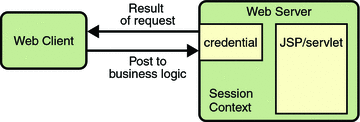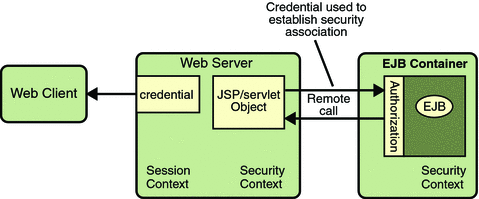A Simple Security Example
The security behavior of a Java EE environment may be better understood by examining what happens in a simple application with a web client, a JSP user interface, and enterprise bean business logic.
In the following example, which is taken from JSR-244, the Java EE 5 Specification , the web client relies on the web server to act as its authentication proxy by collecting user authentication data from the client and using it to establish an authenticated session.
Step 1: Initial Request
In the first step of this example, the web client requests the main application URL. This action is shown in Figure 28–1.
Figure 28–1 Initial Request

Since the client has not yet authenticated itself to the application environment, the server responsible for delivering the web portion of the application (hereafter referred to as web server) detects this and invokes the appropriate authentication mechanism for this resource. For more information on these mechanisms, read Security Implementation Mechanisms.
Step 2: Initial Authentication
The web server returns a form that the web client uses to collect authentication data (for example, user name and password) from the user. The web client forwards the authentication data to the web server, where it is validated by the web server, as shown in Figure 28–2.
Figure 28–2 Initial Authentication

The validation mechanism may be local to a server, or it may leverage the underlying security services. On the basis of the validation, the web server sets a credential for the user.
Step 3: URL Authorization
The credential is used for future determinations of whether the user is authorized to access restricted resources it may request. The web server consults the security policy (derived from the deployment descriptor) associated with the web resource to determine the security roles that are permitted access to the resource. The web container then tests the user’s credential against each role to determine if it can map the user to the role. Figure 28–3 shows this process.
Figure 28–3 URL Authorization

The web server’s evaluation stops with an “is authorized” outcome when the web server is able to map the user to a role. A “not authorized” outcome is reached if the web server is unable to map the user to any of the permitted roles.
Step 4: Fulfilling the Original Request
If the user is authorized, the web server returns the result of the original URL request, as shown in Figure 28–4.
Figure 28–4 Fulfilling the Original Request

In our example, the response URL of a JSP page is returned, enabling the user to post form data that needs to be handled by the business logic component of the application. Read Chapter 30, Securing Web Applications for more information on protecting web applications.
Step 5: Invoking Enterprise Bean Business Methods
The JSP page performs the remote method call to the enterprise bean, using the user’s credential to establish a secure association between the JSP page and the enterprise bean (as shown in Figure 28–5). The association is implemented as two related security contexts, one in the web server and one in the EJB container.
Figure 28–5 Invoking an Enterprise Bean Business Method

The EJB container is responsible for enforcing access control on the enterprise bean method. It consults the security policy (derived from the deployment descriptor) associated with the enterprise bean to determine the security roles that are permitted access to the method. For each role, the EJB container uses the security context associated with the call to determine if it can map the caller to the role.
The container’s evaluation stops with an “is authorized” outcome when the container is able to map the caller’s credential to a role. A “not authorized” outcome is reached if the container is unable to map the caller to any of the permitted roles. A “not authorized” result causes an exception to be thrown by the container, and propagated back to the calling JSP page.
If the call is authorized, the container dispatches control to the enterprise bean method. The result of the bean’s execution of the call is returned to the JSP, and ultimately to the user by the web server and the web client.
Read Chapter 29, Securing Java EE Applications for more information on protecting web applications.
- © 2010, Oracle Corporation and/or its affiliates
